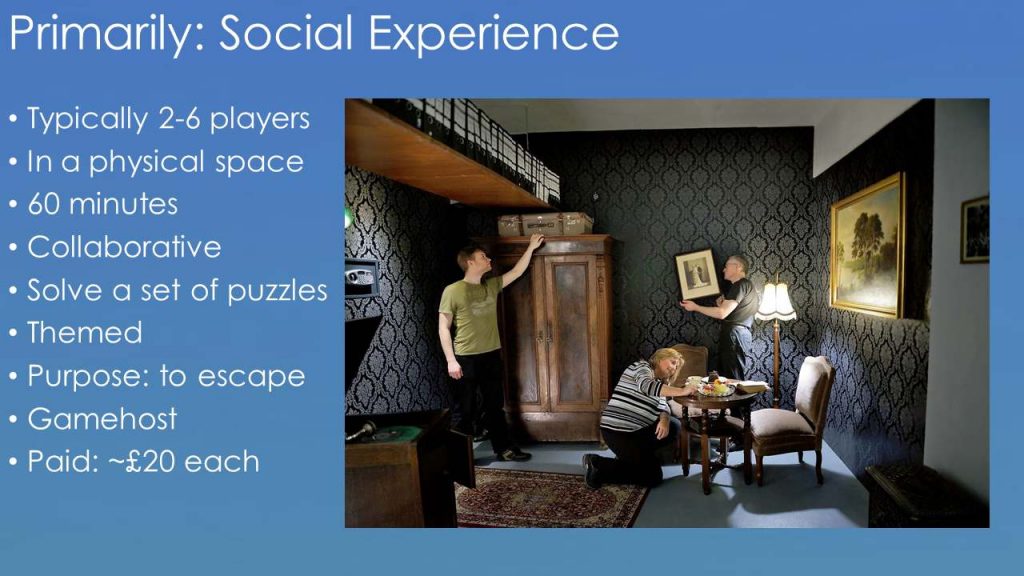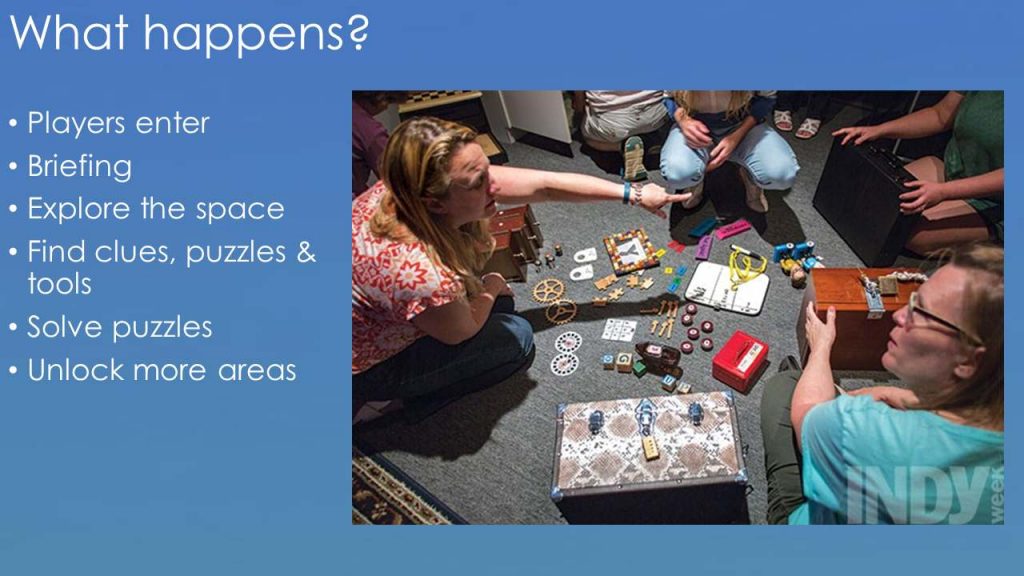Introduction
We’ll start by introducing the concept of Escape Rooms and discuss how this phenomenon that has grown so rapidly in the past 5 years could now be applicable to Museums, Science Centres, Galleries and other public spaces.
Escape Games (also known as Escape Rooms, Locked Room Puzzles, Exit games and live escape games) are a sub-genre of real-world games and often blended with interactive theatre experiences. While these wider experiences have been around for decades it’s only in recent years that they have been distilled into a clear concept that consumers can understand and are willing to pay premium prices for in large volumes.
Aside: Escape Game History
Aside: Escape Game Growth UK
So what are Escape Games?

Escape Games are first and foremost a social experience. A group of friends / family / colleagues come together to challenge themselves in a physical puzzle environment. In the USA it’s possible to join a group of strangers but in the UK this is somewhat rare.
The objective is (usually) to spend the next 60 minutes working together to solve a variety of puzzles (logical, physical, symbolic) to escape the room.
They are themed and have some element of story. Example themes include: Sherlock Holmes, International Spy, Bank Heist, Egyptian, Time travel etc. Earlier games generally had less story and nowadays it is more like walking on to a film set.
Creating a detailed story that links with the puzzles is still a very difficult problem. Not only is it complicated to create puzzles that tie in well with a narrative but players are often so focused on the problem solving tasks ahead of them that they fail to absorb the story elements (we’ll come back to this later in our own games). I think it’s fairer to say that Games are themed around a subject rather than having a compelling narrative.
There will be a game host (also known as a gamemaster or controller) who will be responsible for ensuring that you have a good experience. They will setup the room, meet you before and after and provide hints while players are inside. You can assume that they are watching you on the camera and enjoying your attempts to solve the problems.
What happens in Escape Games?

Players arrive at a venue and are met by the gamehost. The gamehost will have previously been busy resetting the room from the previous players. Player’s receive a game briefing this is usually a combination of practical information and story information. It is reasonably common for this information to be given in character – e.g. if the main protagonist is a mad scientist perhaps our gamehost is playing the part of a lab assistant. Typically the gamehost is the only human character you will interact with – occasionally games will use actors in a room but more often any interaction outside of the host will be pre-recorded video / audio.
Players then enter the room and the door is locked behind them. Most players begin by ‘tossing the room’ – where they will explore everything thoroughly and try to collect together anything that might be part of a puzzle and anything that looks like a barrier / lock / gate.
The main bulk of the game is then figuring out how these puzzle pieces can be used to open new areas of the game. Often many pieces will have no use at the beginning but over time the use becomes apparent. Each time players solve a puzzle they are rewarded with more story and puzzle pieces. It’s common that players will find ‘tools’ which allow them to use existing clues in a new way – e.g. ultra-violet torch, codewheel, red-reveal glasses, magnets etc.
It’s fairly common for games to broadly follow a three act structure, beginning / middle and end. And this is often see in the layout of the games – so the game may even consist of 3 rooms which equate to these sections of the game
It’s worth noting that while the game follows a somewhat linear structure – it is common that puzzles can be solved in a non-linear order. This means that at any one time a team may be working on numerous puzzles. It might be the case that the puzzles are currently unsolvable as the required puzzle pieces aren’t yet in play. This encourages individual players to move between puzzles joining up with others and discussing their thoughts on it. This is often how puzzles are solved. One player stuck on a puzzle thinks they need a particular item to solve it and a second player has already seen something that might work.
Typically there is an overarching puzzle that becomes apparent. An example might be a jigsaw puzzle with a message on – but each sub puzzle provides us with a handful of jigsaw pieces. Players are then aware of short / medium and long term goals which helps to provide focus.
The entire time the gamehost is watching from outside on CCTV cameras. They may be required to trigger game events manually. E.g. one puzzle might be players copying the poses of statues in a photo or perhaps players need to play a musical sequence as a collective. It would be close to impossible to monitor this automatically – so having the gamehost check the answer is much simpler. They generally err on the side of players – if you make a slight mistake on the poses they will probably allow you through.
In addition the gamehost will provide players with hints. These hints can be on a request basis or simply provided when the gamehost thinks you’re struggling. Different venues do this in different ways – some penalise players for requesting help, some have multiple levels of difficulty where you’re allowed a certain amount of help.
It depends on the ethos of the Escape Game venue. In games I make I strive that players of all abilities should get through the game as close as possible to the time limit – just getting out by the skin of their teeth. This is difficult to do as you may need to lengthen the experience by having sections of the game that can be enabled if players are doing very well. Other venues prefer to set the difficulty quite high and pride themselves on having few teams escape successfully – I suspect to encourage repeat visits.
Play an Escape Room
I think it’s almost impossible to begin making your own Escape Room without at least experiencing one for yourself first hand. There are around 1000 rooms in the UK at the time of writing and I’m sure there’s one only a few miles from where you are. No doubt you’ll get bitten by the Escape Room bug and will try to incorporate visits to them whenever you visit a new town / city.
Until you’re able to visit one in person – here’s a video of one being played by a family. As you can imagine there aren’t many venues happy to have their Escape Room and solutions viewed by the entirety of the internet so we’re very fortunate that this exists.
Next
Okay, so now we’ve got a basic understanding of Escape Games. Now it’s time to think about how they could be transferred into museums.